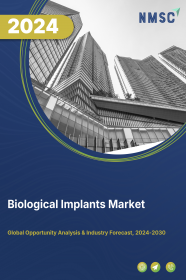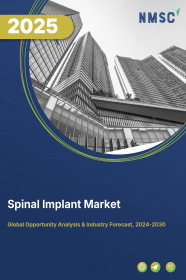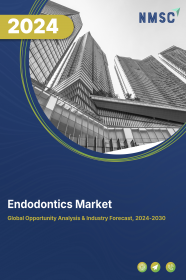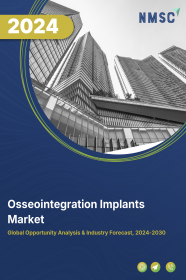
Biological Implants Market by Origin (Allograft, Autograft, Xenograft, and Synthetic), by Type (Cardiovascular Implants, Spinal Implants, Ophthalmic Implants, Neurostimulators Implants, Orthopedics & Trauma, Dental, and Others), by Materials (Biomaterial Metal, Alloys, Ceramics, and Polymers), by Mode of Administration (Surgical and Injectable), and by End User (Ambulatory Surgical Centers, Clinics, Hospitals, and Others): Global Opportunity Analysis and Industry Forecast 2023 - 2030
Market Definition
The global Biological Implants Market size was valued at USD 129.00 billion in 2022, and is predicted to reach USD 267.97 billion by 2030 with a CAGR of 9.6% from 2023 to 2030.
Biological implant is a medical device that is used to replace or support missing or damaged part of a human body. Biologic implants can refer to a bone, soft tissue, or skin that is harvested from a donor’s body and further transplanted into the recipient’s body. Biological implants are made from biosynthetic materials such as collagen and tissue engineered products that include artificial bones, skin, or tissues that are compatible with human body cells. Biological implants devices help in regulating physiological functions of patients that allows them to lead an efficient life.
Market Dynamics and Trends
Increase in demand for biological implants is attribute to growth in orthopedic surgeries around the globe. For instance, in July 2021, Orthofix Medical Inc. announced the launch of fiber fuse strip, which is a unique mixture of mineralized cancellous and demineralized cortical bone to create a natural scaffold allowing revascularization, cellular ingrowth, and new bone formation. Moreover, availability of advanced bio-dental implant products that include Internal Hex Implants and Conical Hex Implants for dental implantation is expected to support growth of the biological implants market.
However, high cost of implants used during various surgeries such as dental, spinal cord, and cardiovascular restrain growth of the market. On the contrary, surge in use of ambulatory services around the globe that provide cost-effective treatment are expected to create ample growth opportunities for the market in the coming years.
Market Segmentation and Scope of the Study
The biological implants market report is segmented on the basis of origin, type, materials, mode of administration, end user, and region. On the basis of origin, the market is classified into allograft, autograft, xenograft, and synthetic. On the basis of type, it is categorized into cardiovascular implants, spinal implants, ophthalmic implants, neurostimulators implants, orthopedics & trauma, dental, and others. The cardiovascular segment is further divided into pacing devices, stents & related implants, and structural cardiac implants. Pacing devices are further sub-segmented into cardiac resynchronization therapy devices (CRTS), implantable cardioverter defibrillators (ICDS), implantable cardiac pacemakers (ICPS), and pacing accessories. Stents & related implants are further categorized into coronary stents, peripheral stents, and stent-related implants.
Coronary stents are further categorized into drug-eluting stents, bare-metal coronary stents, and bioabsorbable stents. Peripheral stents are further divided into endovascular stent-grafts, renal & related stents, femoral & related stents, and carotid stents. Stent-related implant is sub-segmented into synthetic grafts, vascular grafts, peripheral grafts, and vena cava filters. Structural cardiac implants are sub-divided into heart valves & accessories, tissue heart valves, mechanical heart valves, heart valve repair devices, ventricular-assist devices, implantable heart monitors, insertable loop recorders, and implantable hemodynamic monitors. Spinal implants are categorized into thoracolumbar implants, intervertebral spacers, machined allograft spacers, cervical implants, motion preservation implants, and implantable spinal stimulators. Ophthalmic implants are sub-divided into intraocular lens and glaucoma & other lenses. Neurostimulators implants are sub-segmented into cortical stimulators, deep brain stimulators, sacral nerve stimulators, spinal cord stimulators and vagus nerve stimulators.
The orthopedics & trauma segment is again divided into reconstructive joint replacements, orthobiologics, and trauma implants. The reconstructive joint replacements are further sub-classified into knee replacement implants, hip replacement implants and extremities. The dental segment is sub-classified into plate form dental implants and root form dental implants. On the basis of materials, the market is classified into biomaterial metal, alloys, ceramics, and polymers. On the basis of mode of administration, it is bifurcated into surgical and injectable. On the basis of end user, it is divided into ambulatory surgical centers, clinics, hospitals, and others. Geographically, it is analyzed across North America, Europe, Asia-Pacific, and Row.
Geographical analysis
North America holds a predominant share of the biological implants market, and is expected to continue its dominance during the forecast period. This is attributed to factors such as well-established healthcare system in this region and high health care spending by government that enables public healthcare providers to adapt advance biological implant procedures. For instance, in 2020, according to the Centers for Medicare & Medicaid Services (CMS), the U.S. spent 4.1 trillion USD in health care goods and services, public health activities, and investment related to health care in the country.
In addition, growth in use of biological implants in patients with spinal cord injury to treat deformity and stabilize spine with added strength further propels the biological implants market growth in this region. For instance, as of 2022, according to the National Spinal Cord Injury Association, U.S., total number of people living with a spinal cord injury in the country were 450,000 and required biological implants for treatment.
However, Asia-Pacific is expected to show a steady rise in the biological implants market, owing to presence of very high number of geriatric populations in countries such as Japan and China, which are prone to bone injuries and require joint replacement surgeries that use biological implants. For instance, in 2019, according to the Population Reference Bureau (PRB), Japan had the highest number of elderly people across the globe, which accounted as 28.2% of the total population of Japan.
Moreover, rapid increase in medical tourism in countries such as South Korea, Singapore, Malaysia, and India for dental and orthopedic surgeries, as these countries provide high quality medical services at reasonable cost propel growth of the market in this region. For instance, in 2019, according to the Indian Institute of Public administration, total number of international medical tourists in the country was around 697,453.
Competitive Landscape
The biological implants industry comprises various market players such as Abbott Laboratories, Medtronic, Edwards Life sciences Corporation, C R Bard, Medtronic, St Jude Medical, Stryker, DePuy Synthes, Zimmer Biomet, and Arthrex, Inc. These market players are adopting various strategies such as approvals and launches of business across various regions to maintain their dominance in the global market.
For instance, in March 2020, Abbott Laboratories announced that it received CE Mark for FlexNav delivery system for the company's Portico transcatheter aortic valve implantation (TAVI) system. It aims to enable marketing authorization in Europe. This will assist physicians to implant Portico that provides benefits such as improved delivery, flexibility, and navigation in complex cardiac anatomies.
In addiiton, in June 2022, Medtronic introduced its fourth-generation flow diverter called Pipeline Vantage with Shield Technology, which has received CE marking for endovascular treatment. Medtronic launched CE marked for its fourth-generation flow diverter Pipeline Vantage with Shield Technology for endovascular treatment. It comes with enhanced design features for both delivery system and implant. It allows physicians to deliver, deploy, and treat brain aneurysms and intracranial aneurysms with greater ease and reliability, which provides a scaffold that promotes growth of cells in the inner lining of the target blood vessel.
Key Benefits
-
The report provides quantitative analysis and estimations of the biological implants market from 2023 to 2030, which assists in identifying the prevailing market opportunities.
-
The study comprises a deep dive analysis of the biological implants market including the current and future trends to depict prevalent investment pockets in the market.
-
Information related to key drivers, restraints, and opportunities and their impact on the market is provided in the report.
-
Competitive analysis of the players, along with their market share is provided in the report.
-
SWOT analysis and Porters Five Forces model is elaborated in the study.
-
Value chain analysis in the market study provides a clear picture of roles of stakeholders.
Biological Implants Market Key Segments
By Origin
-
Allograft
-
Autograft
-
Xenograft
-
Synthetic
By Type
-
Cardiovascular Implants
-
Pacing Devices
-
Cardiac Resynchronization Therapy Devices (CRTS)
-
Implantable Cardioverter Defibrillators (ICDS)
-
Implantable Cardiac Pacemakers (ICPS)
-
Pacing Accessories
-
-
Stents & Related Implants
-
Coronary Stents
-
Peripheral Stents
-
Stent-Related Implants
-
-
Structural Cardiac Implants
-
Heart Valves & Accessories
-
Tissue Heart Valves
-
Mechanical Heart Valves
-
Heart Valve Repair Devices
-
Ventricular-Assist Devices
-
Implantable Heart Monitors
-
Insertable Loop Recorders
-
Implantable Hemodynamic Monitors
-
-
Spinal Implants
-
Thoracolumbar Implants
-
Intervertebral Spacers
-
Machined Allograft Spacers
-
Cervical Implants
-
Motion Preservation Implants
-
Implantable Spinal Stimulators
-
-
Ophthalmic Implants
-
Intraocular Lens
-
Glaucoma & Other Lenses
-
-
Neurostimulators Implants
-
Cortical Stimulators
-
Deep Brain Stimulators
-
Sacral Nerve Stimulators
-
Spinal Cord Stimulators
-
Vagus Nerve Stimulators
-
-
Orthopedics & Trauma
-
Reconstructive Joint Replacements
-
Knee Replacement Implants
-
Hip Replacement Implants
-
Extremities
-
-
Orthobiologics
-
Trauma Implants
-
-
Dental
-
Plate Form Dental Implants
-
Root Form Dental Implants
-
-
Others
-
By Materials
-
Biomaterial metal
-
Alloys
-
Ceramics
-
Polymers
By Mode of Administration
-
Surgical
-
Injectable
By End User
-
Ambulatory Surgical Centers
-
Clinics
-
Hospital
-
Others
By Region
-
North America
-
U.S
-
Canada
-
Mexico
-
-
Europe
-
U.K
-
Germany
-
France
-
Italy
-
Spain
-
Denmark
-
Netherlands
-
Finland
-
Sweden
-
Norway
-
Russia
-
Rest of Europe
-
-
Asia-Pacific
-
China
-
Japan
-
India
-
South Korea
-
Australia
-
Indonesia
-
Singapore
-
Taiwan
-
Thailand
-
Rest of Asia-Pacific
-
-
RoW
-
Latin America
-
Middle East
-
Africa
-
Key Players
-
Abbott Laboratories
-
Medtronic
-
Edwards Life sciences Corporation
-
C R Bard
-
Medtronic
-
St Jude Medical
-
Stryker
-
DePuy Synthes
-
Zimmer Biomet
-
Arthrex, Inc.




















 Speak to Our Analyst
Speak to Our Analyst





















